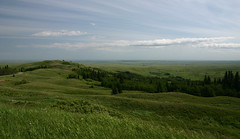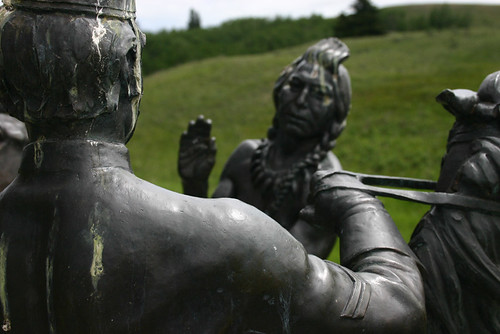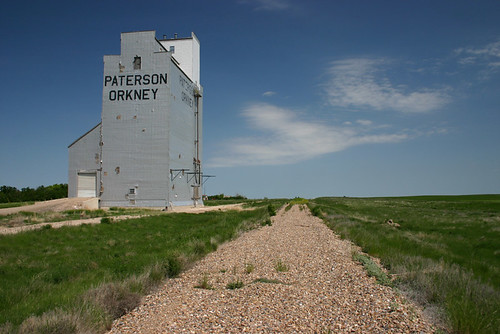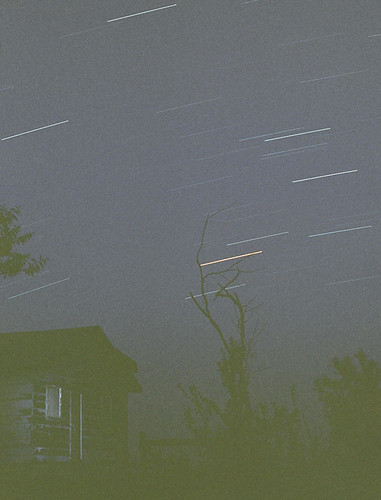I wonder what it was like in the hills here 10,000 years ago. During the last ice age, when ice sheets half a kilometre thick covered the prairies, the Cypress Hills were spared. They were they only oasis of land between the Rockies and the Atlantic Ocean. I can't imagine.

View from an island. The plains in the distance were covered in ice during the last ice age.
The trip through the park was nice. The weather was sunny and warm and there was no other traffic on the road, which wasn't surprising because it was a dirt road. Not gravel. Dirt. I learned later, the next day actually, that there is a profound difference between a gravel and dirt road. While travelling this dirt road I came across a mob, if that's the right word, of butterflies in the middle of the road lunching on a pile of shit. Ah, such vile beauty. I also came across a funny sign that posted both the speed limit, 40 kilometres and hour, and a warning that speed limits are enforced using photo-radar. Good luck getting a ticket on these roads.
Once I was on the Saskatchewan side I took a short detour to the Fort Walsh National Historic Site.

Fort Walsh was established by the North West Mounted Police in the late 1800's. It was built in response to the massacre of Nakoda people in 1873 by a group of angry white men on horses who rode up from Montana looking for horse thieves. Among other things, the fort aided Lakoda refugees led by Sitting Bull who were fleeing the Sioux wars of 1876-1877. A bronze statue at the information centre marks Sitting Bull's arrival at the fort.
I left the park and was momentarily filled with glee that I was once again driving on asphalt. It was a short lived glee. Every few hundred metres there were signs warning drivers about 'pavement breaks' which were accompanied by little red markers placed at road level right where the pavement was broken. The pavement was really broken. Reall, really broken. There were times I would drive 200 too 300 metres on the wrong side of the road to avoid broken pavement.
Now, of course this was not the Trans Canada Highway I was on. This was more a tertiary highway and I suppose in the grand scheme of things traffic levels don't justify the outlay of money for repairs. It was not just roads that were neglected. The rail line had been taken out too, and whole towns were disappearing.
I passed through Climax, where I had to go just to say I had been to Climax, with its cute though predictable sign on the way out of town that reads, 'Hope you enjoyed Climax, please come again,' and soon came to Orkney. About 40 km of highway 18 separates Climax and Orkney, and what a difference 40 km can make. Orkney is a town no longer. As a kid I used to think of ghost towns as a cowboy, old-west kind of thing. But they are a new-west kind of thing too. And at the root of the emptying of urban settlements like Orkney looms large a simple fact: the rail road goeth no longer.

There is not much left in Orkney. Homes and businesses are abandoned, the school is empty, and what was once a commercial block is now evident only from the outline of its building's overgrown foundations. The population of white-tail deer was higher than that of humans.

There were still two homes in town that looked occupied, but I didn't have time to get nosy with the residents. While taking photos of a row of houses, I came around a corner and startled two white-tail deer, who promptly startled me. The whole town was eerily silent, save for the songs of birds and the whispering of a warm prairie wind. Periodically a car drove through town, east to west, west to east, didn't matter, the driver's eyes firmly planted on the road ahead. Sometimes it's rude to stare at wrecks at the side of the road.
I arrived at Grasslands National Park in the late afternoon, checked in at the park office, then headed into the vast open space of the park for the night. I didn't take many notes that night. I was a little overwhelmed by the scenery. Following is my last journal entry for the day.
June 13, 2006
Stars in a prairie sky.
Eleven minutes remain on my first long exposure photo of the night. Sitting in the tent doorway, I realize I am happier than I have been for a very long time. Above me the biggest sky I have ever seen, full of stars, wonder and promise.
I can't imagine a better way to end the day than with a full moon rising.

